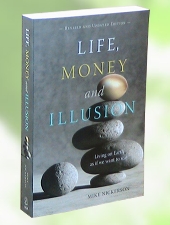The whole story:

Life, Money
and Illusion
The Origin of the More Fun, Less Stuff meme
Interest has been expressed as to the origin of the More Fun, Less Stuff meme.
In the early 1970s I was one of a dozen-plus young adults who worked together under the banner of the Institute for the Study of Cultural Evolution—ISCE. The title was a flag asking ‘what do you know about social change?’
The focus of our study was voluntary and non-profit organizations. We sought to weed out ideas that were stimulated by the profit motive. With that precaution, however, we would look at such material when it was recommended by our target groups.
What are the problems and solutions of our times?
After four years of note-taking, the material collected was boiled down to eight key points:
Solutions
Well-being can be sustained when activities:
#1 Use materials in continuous cycles.
#2 Use continuously reliable sources of energy.
#3 Come mainly from the qualities of being human (i.e. creativity, communication, coordination, appreciation, and spiritual and intellectual development.)Problems
Long-term well-being is diminished when activities:
#4 Require continual inputs of non-renewable resources.
#5 Use renewable resources faster than their rate of renewal.
#6 Cause cumulative degradation of the environment.
#7 Require resources in quantities that undermine other people's well-being.
#8 Lead to the extinction of other life forms.
In 1974 a friend looked at these points and said they were a definition of sustainability. The word wasn’t in circulation at that time. Wondering how a study of voluntary and non-profit efforts resulted in a definition of sustainability, we realized that voluntary efforts are the natural immune system of society. Citizens groups emerge wherever there are problems in society.
While sharing these Guideposts for a Sustainable Future as an educational endeavour, we asked further:
• Is this what we mean by sustainability?
• If it is not, upon what point or points do you disagree?
• For what reasons?
• Is there anything missing?
Except for comments that #7 should be more specific about various inequities, no further suggestions were made.
Into the 1990s, we started promoting A Question of Direction. Do we want to continue pursuing Economic Growth or should we aim for Sustainability?
We distributed over 800,000 business card--size copies of the question. Roughly 140 words. Far more than can be spoken while retaining the interest of a listener. It did, however, appear that people were willing to read it all—a read bite, so to speak.
Then the four syllables showed up in a random Internet post: “More Fun, Less Stuff”.
In essence it represents the Question of Direction, but does so at a scale that it can enter a mind faster than thought processes can justify it away. Catchy and easily remembered, we are now using it as a handle both to question Growth Everlasting and to point the way toward a social form that might endure. An anchor for a new narrative, perhaps.
Visually, in eight minutes: To Be Alive and Well; It’s Easier Than You Think.
